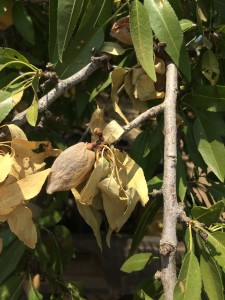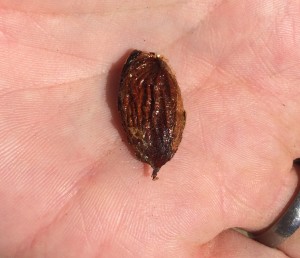
Over the past week, a few interesting observations have been made. These include:
1. Hull rot in Nonpareil appears worse in many ‘Nonpareil’ orchards. This is most likely due to the higher-than-normal humidity levels experienced during the initiation of hull-split. Most of the hull rot appears to be from the black bread mold Rhizopus. The dieback being observed is from the translocation of the toxin back into the limb. This often causes gumming which can reduce the ability to remove nuts during shaking. Applying a fungicide now will not cure the infections or prevent the movement of the toxin.
2. There have been several reports of Fuller Rose Beetles clogging micro-sprinklers. These insects lay a mass of eggs in the opening of the sprinklers, reducing water flow. Surprisingly, reports are even coming from growers who have switched to pop-up micro-sprinklers, which are considered more resistant to clogging. This nocturnal beetle has one generation per year with most of the adult activity occurring in August – October. The beetle needs to feed on leaves for a few weeks prior to laying eggs. Although chemigation of the soil is not effective for controlling the insect or eggs, there is some thought that treating the trunks with a registered broad spectrum insecticide may kill the beetle as it migrates from the soil to the trunk. If attempting this strategy, be wary of the PHI of the product you are planning to use. More information can be found in this presentation and at the UC IPM website (You may need to look under a different crop). Keep in mind that the best long-term management of this pest has been through the use of clog resistant, pop-up type microsprinklers.

3. Reports of gummy kernels from boron deficiency and stuck nuts from boron toxicity. Gummy kernels that occur may be due to boron deficiency and a hull analysis should be performed. Interestingly enough, stick tights due to boron toxicity has also been reported. This is most likely due to an increase of plantings into areas with soil or well water with high boron levels.
4. It is hot and trees are requiring a lot of water. Try to reduce stress as much as possible through this period by irrigating as soon as possible after harvest. Post harvest irrigation is critical to help maintain consistent, high yielding crops.
5. Be cautious with the post harvest nitrogen applications. Nitrogen should only be applied to trees that have been shook. Applying large amounts of nitrogen now to later harvesting varieties may flare hull rot. Keep in mind that research has shown that due to the shorter days and generally lower evapotranspiration rates of the fall, almond trees do not uptake more than 50 lbs of nitrogen per acre. More information on postharvest fertilization can be found here.

